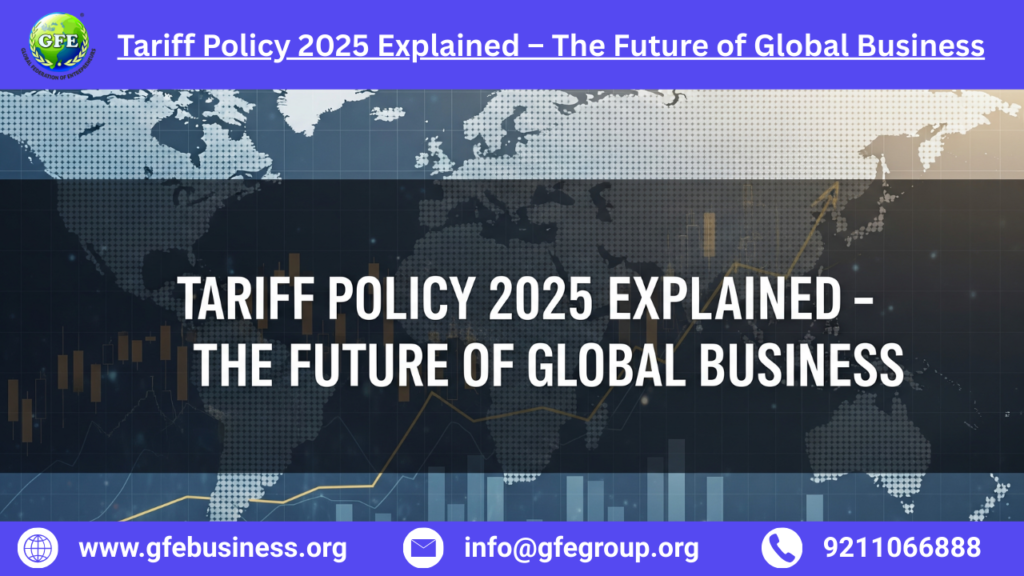Trade policies are never static—they evolve with geopolitics, economic shifts, and domestic priorities. Tariff Policy 2025 is shaping the rules of global trade at a time when protectionism and free trade are colliding. For exporters and importers, tariffs are no longer just a tax—they’re a strategic factor that determines pricing, competitiveness, and market entry.
Institutions like the World Trade Organization (WTO) and regional free trade agreements play a vital role in determining how nations approach tariffs. At the same time, businesses need platforms such as GFE Business to interpret these changes and act quickly in international markets.
In this article, we’ll explain:
What Tariff Policy 2025 means for global trade.
Key features shaping its framework.
The impact on Indian exporters and international businesses.
How to navigate tariff shifts strategically.
Case studies showing adaptation to new tariff regimes.
What is Tariff Policy 2025?
Tariff Policy 2025 is the collective term for the global tariff frameworks being revised in 2025. It includes national tariff updates, bilateral trade agreements, and multilateral negotiations. Its focus is to balance domestic protection with global competitiveness.
For example, the U.S. has introduced steep tariffs (up to 50%) on certain imports from India and China, while the European Union is pushing for sustainability-linked tariff structures. Emerging economies like India are negotiating trade deals to counterbalance these impacts.
This shift indicates a new era where tariffs are not just about raising government revenue but about influencing supply chains, sustainability, and geopolitical power.
Why Tariff Policy 2025 Matters
Tariffs have always influenced trade, but in 2025, the stakes are higher:
Cost Competitiveness: A 5% tariff can make or break profitability in industries like textiles and seafood.
Supply Chain Relocation: Tariff hikes often force companies to move production.
Geopolitical Strategy: Tariffs are now bargaining chips in global diplomacy.
Market Diversification: Exporters need to explore low-tariff markets like UAE, Japan, and Australia.
Key Features of Tariff Policy 2025
1. High Tariffs in Developed Economies
Countries like the U.S. are raising tariffs to protect local industries. Indian exporters in textiles, gems, and shrimp face steep duties, reshaping supply chains.
2. Preferential Trade Agreements (FTAs, CEPAs, ECTAs)
India–UAE CEPA and India–Australia ECTA ensure duty-free access for over 90% of products. According to The Economic Times, India is also finalizing deals with the UK and EU.
3. Sustainability-Linked Tariffs
The EU’s Carbon Border Adjustment Mechanism (CBAM) links tariffs to carbon emissions, pushing exporters to adopt greener practices.
4. Digital Tariff Monitoring
Tools like World Bank’s WITS and UNCTAD Trade Statistics enable businesses to track tariff schedules in real time.
Impact on Global Business
For Exporters:
Need to align product pricing with tariff updates.
Must explore alternative low-tariff markets.
Competitive edge if leveraging FTAs effectively.
For Importers:
Higher costs when sourcing from tariff-heavy countries.
Incentives to shift supply chains to India or Southeast Asia.
For Startups & SMEs:
Tariff Policy 2025 may increase compliance costs.
But FTAs open new market opportunities if documentation is proper.
Tariff Policy 2025 and Indian Exporters
Indian exporters face both challenges and opportunities:
Challenges:
U.S. tariffs of up to 50% on shrimp, textiles, and gems.
EU sustainability-linked tariffs require compliance upgrades.
Opportunities:
UAE, UK, Japan, and Australia offer near-zero tariffs under trade agreements.
India’s pharmaceutical and engineering exports are gaining an edge in these low-duty markets.
For SMEs in Surat, Tiruppur, or Andhra Pradesh, adapting to these tariff shifts can mean the difference between losing markets and expanding globally.
How Businesses Can Adapt
Step 1: Leverage FTAs
Identify which agreements your products fall under. For example, the India–UAE CEPA eliminates tariffs on 90% of products.
Step 2: Map HS Codes to Tariff Schedules
Use WTO or WITS databases to verify tariff rates before exporting.
Step 3: File Certificates of Origin (COOs)
Only valid COOs qualify for preferential tariffs. In 2024–25, India issued over 720,000 COOs.
Step 4: Rework Pricing Models
Factor tariff advantages into quotations. Example: “Our textile exports to UAE save 5% due to CEPA duty elimination.”
Step 5: Diversify Markets
Instead of relying heavily on the U.S., Indian exporters must target UAE, Japan, and Australia for tariff-friendly access.
Case Studies
Indian Shrimp Exporters
Andhra Pradesh exporters faced U.S. tariffs but redirected shipments to Japan under CEPA, achieving 20% volume growth.
Textiles from Surat
Under the India–UK FTA, exporters gained duty-free entry into UK retail chains, boosting competitiveness against Bangladesh.
Pharma to Australia
Hyderabad-based API firms leveraged ECTA to secure new contracts at zero duty.
Risks and Limitations
Non-Tariff Barriers: Compliance standards in the EU and Japan.
Documentation Errors: Wrong COO filings lead to loss of benefits.
Competitor Advantage: Vietnam and Bangladesh sometimes enjoy better tariff access.
Over-Reliance: Heavy focus on one low-tariff market can be risky.
The Future of Tariff Policy Beyond 2025
Looking ahead, Tariff Policy 2025 will expand in three ways:
Green Tariffs: Linking duties to carbon emissions.
Digital Trade Facilitation: AI-driven tariff management.
Multipolar Trade Deals: India–EU, India–Canada, and India–EAEU agreements in progress.
Businesses that stay agile and data-driven will thrive in this environment.
Final Thoughts
Tariff Policy 2025 is not just about trade barriers—it’s a blueprint for how businesses must adapt in a shifting global economy. Exporters who rely solely on traditional markets risk losing competitiveness, while those who explore FTAs, monitor tariff databases, and diversify destinations stand to gain.
Platforms like GFE Business simplify this transition—helping exporters with HS code validation, COO filing, and tariff intelligence. At the same time, resources like the WTO, WITS, and UNCTAD ensure that businesses remain informed and prepared.
For Indian and global exporters alike, Tariff Policy 2025 is the new reality—those who adapt smartly will define the future of global business.








